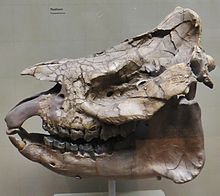Prosantorhinus
| Prosantorhinus Temporal range: Miocene
| |
|---|---|

| |
| Scientific classification | |
| Domain: | Eukaryota |
| Kingdom: | Animalia |
| Phylum: | Chordata |
| Class: | Mammalia |
| Order: | Perissodactyla |
| Family: | Rhinocerotidae |
| Subfamily: | †Aceratheriinae |
| Genus: | †Prosantorhinus Heissig, 1973[1] |
| Species | |
|
Prosantorhinus douvillei | |
Prosantorhinus is an extinct genus of rhinocerotid that lived during the Early and Middle Miocene subepochs. The small teleoceratine rhinocerotid was found in Western Europe and Asia.[2]
Description
[edit]Prosantorhinus was a similarly sized animal to the Sumatran rhinoceros, it stood at around 4'3" (130 cm) at the shoulder and was about 9'6" (290cm) long, weight estimates however are considerably bigger due to its considerably deeper chest.[3] The body plan of Prosantorhinus is stubbier than that of other rhinocerotids, and its brachyodont molars would seem to suggest Prosantorhinus led a semiaquatic life, similar to a hippopotamus, possibly feeding on fresh water plants.[4][5] The tooth eruption sequence of P. germanicus was identical to that of the present-day black rhinoceros, suggesting that it was a slow-growing and long-lived mammal.[6] The rugged texture at the tip of its snout could suggest the existence of one, maybe two, small horns; however it has been traditionally reconstructed with a fleshy bump.[7]
Palaeoecology
[edit]Study of the dental mesowear and microwear of P. douvillei reveals that it was a folivorous browser.[8]
References
[edit]- ^ "Prosantorhinus". Fossilworks.
- ^ Antoine, P-O.; Bulot, C.; Ginsburg, L. (2000). "Une faune rare de rhinocérotidés (Mammalia, Perissodactyla) dan le Miocène inférieur de Pellecahus (Gers, France)". Geobios. 33 (2): 249–255. Bibcode:2000Geobi..33..249A. doi:10.1016/S0016-6995(00)80022-4.
- ^ Hernández Fernández, Manuel; Ansón, Marco. "Artistic reconstruction of the appearance of Prosantorhinus Heissig, 1974, the teleoceratine rhinoceros from the Middle Miocene of Somosaguas". ResearchGate. Spanish Journal of Paleontology. Retrieved 23 September 2021.
- ^ Agustí, Jordi; Antón, Mauricio (2002). Mammoths, Sabertooths, and Hominids: 65 Million Years of Mammalian Evolution in Europe. Columbia University Press. p. 113. ISBN 9780231116411.
- ^ Heissig, K. (1999): Family Rhinocerotidae. - In: Rossner, G. E. & Heissig, K. (Eds.): The Miocene Land Mammals of Europe, 175-188; Munich (Pfeil).
- ^ Böhmer, Christine; Heissig, Kurt; Rössner, Gertrud E. (9 November 2015). "Dental Eruption Series and Replacement Pattern in Miocene Prosantorhinus (Rhinocerotidae) as Revealed by Macroscopy and X-ray: Implications for Ontogeny and Mortality Profile". Journal of Mammalian Evolution. 23 (3): 265–279. doi:10.1007/s10914-015-9313-x. ISSN 1064-7554. Retrieved 14 November 2024 – via Springer Link.
- ^ Cerdeño, Esperanza (1996-01-01). "Prosantorhinus, the small teleoceratinerhinocerotid from the Miocene of Western Europe". Geobios. 29 (1): 111–124. Bibcode:1996Geobi..29..111C. doi:10.1016/S0016-6995(96)80077-5. ISSN 0016-6995. Retrieved 2021-09-21.
- ^ Hullot, Manon; Laurent, Yves; Merceron, Gildas; Antoine, Pierre-Olivier (2021). "Paleoecology of the Rhinocerotidae (Mammalia, Perissodactyla) from Béon 1, Montréal-du-Gers (late early Miocene, SW France): Insights from dental microwear texture analysis, mesowear, and enamel hypoplasia". Palaeontologia Electronica. doi:10.26879/1163. Retrieved 29 November 2024.









